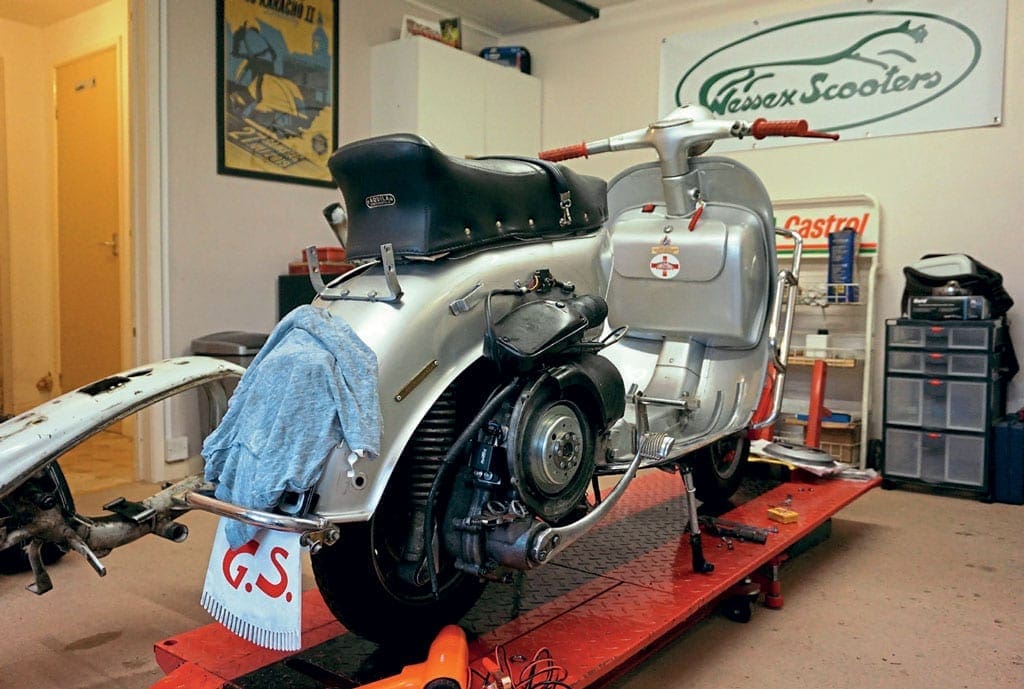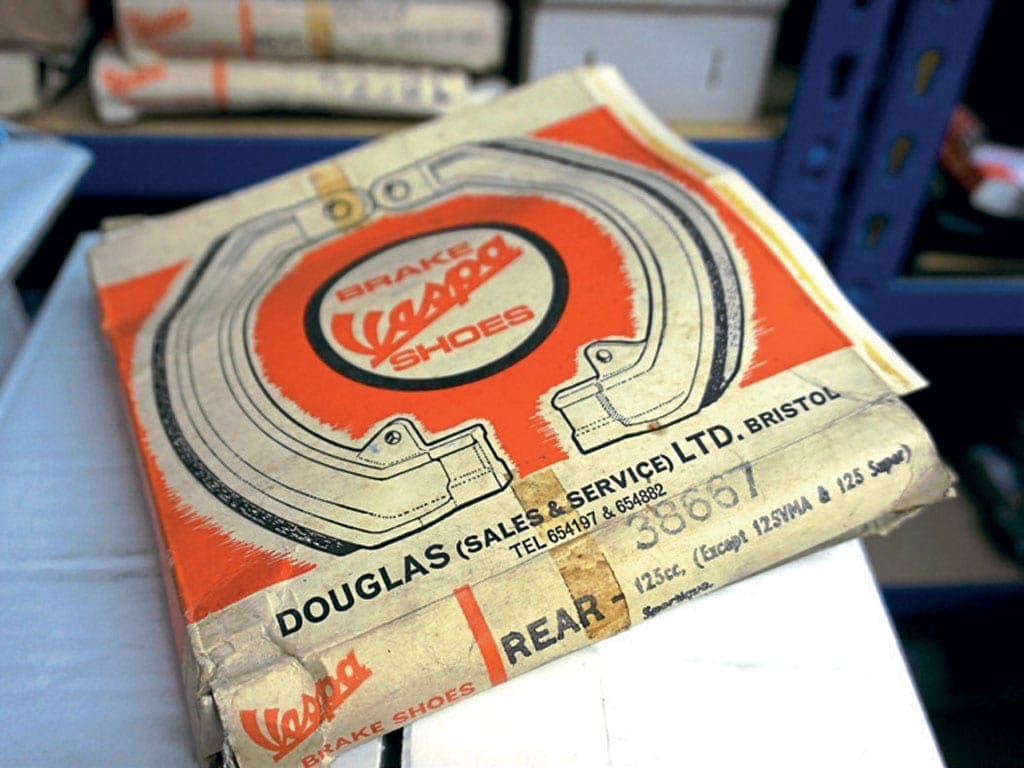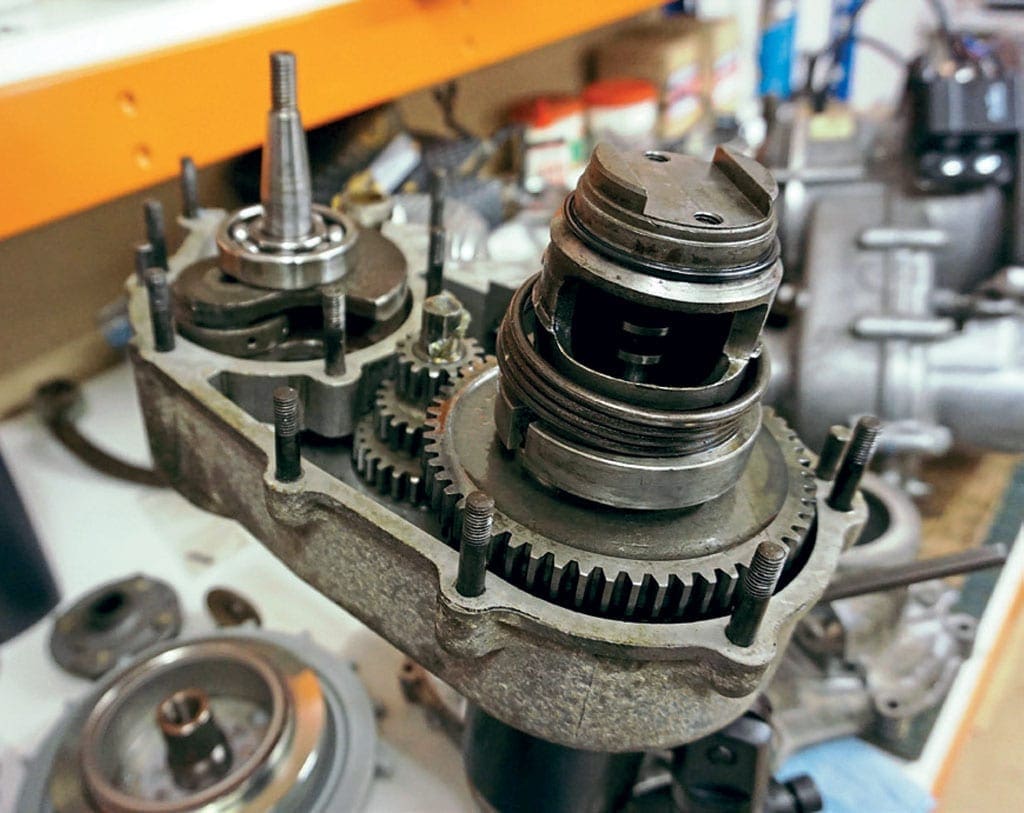
Words & Photographs: Stan
The Vespa wide frame is a mystery to most British riders, but as Stan discovered, Wessex Scooters are determined to bring it out of the shadows.
I’ve visited scooter dealers located everywhere from modern retail parks to Victorian mills, but the directions for Wessex Scooters were definitely a first.
“Just follow signs for the Atomic Weapons Establishment, look for a red post box, go past the ‘Do Not Enter’ signs and we’re in there,” were the cryptic directions given by Wessex Scooters’ Roger Green.
The scene that greeted me was sheer scootering perfection. A 1950s Vespa was parked outside a wooden outbuilding, whilst inside Roger and his business partner Neil Humphrey were working on a GS. It could have been a scene from the 1950s, and from the outset it was clear that both Roger and Neil have a shared passion for this era of Italian scooters.

Whilst the mainstay of British scooterists are of an age to have been influenced by ‘that film’, Roger is of a much younger generation. “I was a teenager during the Brit Pop era,” he said.“I noticed scooters in the background of music videos and TV shows. Even Lucozade featured them! I thought they were the coolest thing I’d seen.
“My first rally was the Isle of Wight in 1999 when I was a clueless, skint 16-year-old on a Honda Vision. Somehow I stumbled on the gang from Allstyles and they took me under their wing. I knew that this was something I wanted to be involved in and from the outset it was Vespa that held my interest.”
In contrast, Neil has been around scooters since 1984. A trained engineer, he too shares a passion for earlier machinery, but that wasn’t always the case.

“I look back to the 1980s and think of the Series 1 and 2s that we cut down or generally abused. I was only interested in GPs and what a waste that was. The Europeans are years ahead of the UK in appreciating the charm of 1950s’ designs, but that’s changing slowly.”
A quick glance at the catalogues of Pinasco, SIP and Scooter Center show that Neil may be right. The past few years have seen an explosion of tuning products aimed at what’s previously been seen as a niche market.
Whether driven by the desire to own something different to a PX, or by the rising prices of 1960s and 1970s classics, British scooterists are now looking at older Vespas such as the Douglas Rod, 92L2 and Sportique with fresh eyes.
“I think the Douglas Vespa has been overlooked for too long,” said Roger. “People forget that those early machines were British. They were assembled in Bristol from castings made on site and the metal was pressed in Birmingham. They’re British scooters and I think that’s something many riders have forgotten.”

It’s easy to get caught up in the romance of riding a 1950s Vespa, but there’s no place for rose-tinted glasses when it comes to the realities of owning one.
“We’re dealing with technology that’s often 70 years old,” admitted Neil. “They aren’t really suitable for use on modern roads. If I can sum up Wessex Scooters in a sentence, it’s bringing those scooters back to life in a way that suits the modern rider.”
The GS 150 VS5 on Neil’s workbench is a good example of this. “The GS is one of the most beautiful scooters ever made, but whoever designed the electrics should be ashamed. I understand why they wired a battery into the ignition circuit.
“This is a sporting scooter and needs a good spark, but when the battery goes flat it won’t start. It’s a flawed design and was never repeated. Changing that to a modern electronic ignition system makes good practical sense.” Neil paused before adding: “There’s also the issue of speed.”
Although the GS is a notable exception, the performance of these early machines can best be described as ‘sedate’. The most popular solution has been to transplant a PX engine and upgrade to 10” wheels.

This isn’t a straightforward process, requiring a special cradle to accommodate the PX’s narrower swinging arm, whilst some frames require cutting to accommodate a larger air filter box. Even setting aside this butchery, many enthusiasts see transplants as cheating. After all, the charm of these machines is their antiquity and it’s here that Wessex Scooters come into their own.
“We’re fortunate to have a good relationship with Pinasco and Andreas at Nagy Blechroller. He’s pioneered wide-frame tuning and worked with Pinasco since 2015. At the moment we’re trying three combinations of the 160cc ‘Nordkapp’ kit, each of which has different characteristics.”
One component shared by most of Wessex Scooters builds is a 12v Flytech electronic ignition. This has proven to be reliable in use and perfectly suits Wessex Scooters’ ethos of usable originality.
In addition to rebuilds and servicing, Wessex Scooters also stock a range of re-made and original parts, although supplies of the latter are getting harder to locate. A limited number of parts have been produced under the Wessex Scooters brand, but for the foreseeable future their relationship with Pinasco will take priority.

International recognition of their expertise has also come in being selected by SIP to test their soon-to-be released wide-frame cable sets, which Roger describes as “excellent”.
Although their current premises are idyllic, they’re not particularly accessible, and as the business grows a move is planned for the near future. Given their mission to take the wide-frame off the secret list, moving from the Atomic Weapons Establishment’s shadow may not be a bad idea!



